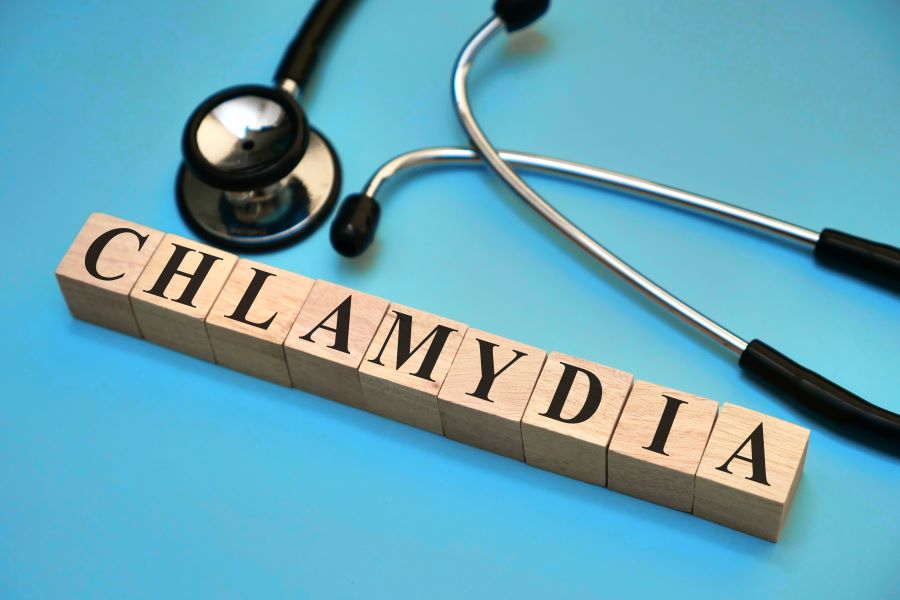Chlamydia, a prevalent sexually transmitted infection (STI) originating from bacterial infection,often has no symptoms during its initial stages.
Chlamydia is a sexually transmitted infection caused by the Chlamydia trachomatis bacteria. It usually goes unnoticed in its early stages. According to the NHS, over 70% of women and at least 50% of men with chlamydia may not experience any noticeable symptoms.
Failing to treat it early can cause serious health issues. Hence, those at risk should undergo regular screenings.
See a Doctor if you have symptoms of Chlamydia.
Chlamydia symptoms typically manifest within 1 to 3 weeks after contact. These symptoms can differ between women and men
Chlamydia Symptoms in Women:
- Abnormal vaginal discharge with an odour
- Bleeding between periods
- Abdominal pain
- Pain during sexual intercourse
- Itching or burning sensation in and around the vagina
- Painful urination
Chlamydia Symptoms in Men:
- Clear or cloudy discharge gets expelled from the tip of the penis
- Painful urination
- Burning and itching around the penis opening
- Pain and swelling in the testicles
Unprotected sexual activity can also lead to Chlamydia affecting other body parts, such as the anus, throat, and eyes, with symptoms including:
Anus: Discomfort and discharge
Throat: Typically, no noticeable symptoms
Eyes: Redness, pain, and discharge
Prevention is key. So, seek prompt medical attention if you experience any of these symptoms.
Pelvic – infection of the female reproductive tract like around ovaries, often causes severe pain and fever
Chlamydia throat symptoms
- chlamydia can also affect your throat if you have oral sex without a condom, but this doesn’t usually cause symptoms
Chlamydia in anus
- women and men can also develop Chlamydia in their anus, which often causes no symptoms
Chlamydia in eyes
- you can get conjunctivitis symptoms in your eye if it comes into contact with body fluids infected with Chlamydia
Does Chlamydia go away?
- Chlamydia infections clear with antibiotics as it is caused by bacteria. It’s usually a quick and simple treatment.
- Without treatment, the infection may linger a lot longer and go onto cause complications like inflammatory disease or infertility
Chlamydia diagnosis and Tests
- The most common ways are
- A swab taken from your vagina in women
- Urine sample in men
- In some cases, we test additional places, like your throat or anus, but this will usually depend on your symptoms
Self-test kits for Chlamydia
Chlamydia self-test kits are available in pharmacies and online. If you test positive, speak to a doctor for prescription-only antibiotics. Remember, as doctors, we are here to support you, so please don’t feel embarrassed.
Treatment of Chlamydia
Your Doctor will prescribe you antibiotics once the test results are positive. Your physician might put you on treatment before the results are out in case of symptoms. Antibiotics like Doxycycline and Azithromycin are found effective in 95% of cases.
These are approximate treatments – do not self treat – see a doctor so we can decide the most appropriate treatment for you. Doxycycline is usually prescribed once daily for a week. Azithromycin doses begin from the lowest of 1g to a maximum of 500 mg once daily for two days.
Your Doctor might even prescribe different antibiotics. Your healthcare professional might foresee possible health complications of Chlamydia. In that scenario, your course of antibiotics could be lengthy e.g. with pelvic inflammatory disease, you likely need a longer course.
The side effects involving the treatment are usually mild. They include stomach ache, diarrhea, feeling tired or sick. Women might occasionally experience thrush.
Are you guaranteed to get Chlamydia if your partner has it?
If you’ve been diagnosed with Chlamydia, your partner must undergo treatment, too—either way. You don’t usually need a test.
How long does it take for Chlamydia to go away?
Complete the prescribed course of antibiotics and abstain from sexual activity for seven days. you can return to sexual intercourse if your partner has also been treated and waited 7 days. Engaging in sexual activity too soon can lead to reinfection [ if you haven’t had the course and waited 7 days], including from activities like oral sex,.
In the United States, it is current practice to undergo a follow-up test approximately three months later to verify the eradication of the infection. However, retesting is typically not a routine requirement in the United Kingdom. This can change over time so always follow your healthcare provider’s advice to ensure the most appropriate post-treatment care.
Long-term effects of Chlamydia in females
- Pelvic inflammatory disease in women (PID) is a serious infection of your reproductive organs. It can lead to scarring and damage to the fallopian tubes, uterus, and ovaries. PID can cause chronic pain and infertility.
- Ectopic pregnancy in women is a case where the fallopian tubes are damaged or blocked. The fertilized egg may implant outside the uterus, resulting in an ectopic pregnancy. This is a medical emergency that can be life-threatening.
- Chronic pelvic pain causes scarring and damage to the reproductive organs. The condition can cause chronic pelvic pain lasting for months or years.
Long-term effects of Chlamydia in males
Prostatitis and epididymitis is a condition that could be caused by Chlamydia. It can cause infections of the prostate gland and epididymis, which can lead to infertility and chronic pain if infection is left untreated .
Long-term effects of Chlamydia in both the sexes
Chlamydia can cause scarring and blockages in the fallopian tubes, preventing the egg from reaching the uterus in females, while blocking the normal movement of sperm. Either way, it can lead to infertility.
How can you cut down the risk of chlamydia transmission?
To lower your risk of getting infected:
- Always use a condom during sexual activity including oral sex .
- If you’re having sex without a condom, consult your Doctor for regular chlamydia tests.
- Seek medical attention if you experience pain while urinating, unusual discharge, or abdominal discomfort.
- If you or your partner show symptoms, it’s best to refrain from sexual activity.
- If you use sex toys, avoid sharing them. But if you do, clean them thoroughly after use and cover any toys used for penetration with a condom.
Are Chlamydia and Gonorrhoea treated the same?
Chlamydia and Gonorrhoea are two types of STIs. Different kinds of bacteria cause them. To treat them, you need different antibiotics. However, if you carry both, your Doctor might give you specific antibiotics to deal with infections together.
Summary
Chlamydia is a common sexually transmitted infection (STI). It often shows no signs, so if you’re sexually active, regular testing is crucial. Without treatment, it can lead to serious issues like pelvic inflammatory disease, infertility, and a higher risk of HIV. Fortunately, it’s diagnosed easily and treated with antibiotics. To prevent it, use condoms correctly and get regular STI tests.
References:
https://www.healthline.com/health/std/chlamydia.
https://www.webmd.com/sexual-conditions/chlamydia

